Seabed Mapping: A Brief History from Meaningful Words
Abstract
1. Introduction
2. Materials and Methods
- word clouds—graphically interesting by enabling the quick identification of more frequent words (more frequent word is larger in size). The words were only analyzed in active forms, i.e., supplementary forms (such as pronouns, articles and prepositions) were not included in the results;
- similarity graphs, which are based on graph theory used to observe and describe the connection among the words [26]. The analysis performed considered the relations and co-occurrence (similar to Euclidean Distance) among the 100 most frequent words, and the graphic chosen for this result was “Fruchterman Reingold (force-directed layout algorithm—the default for Iramuteq—which considers the connection thickness between the words to define the dispersion of the main vertices) [27], Score Co-occurrence with Halo Communities”. From this configuration, the higher the frequency that two words appear close, the thicker the grey connections become.
3. Results and Discussions
3.1. Seabed Mapping Temporal Evolution
3.2. The Seabed Mapping Science of the Two Last Decades in Focus
3.3. Importance, Applicability, and Future Directions of Seabed Mapping
4. Conclusions
Supplementary Materials
Author Contributions
Funding
Acknowledgments
Conflicts of Interest
References
- Maury, M.F. The Physical Geography of the Sea; Sampson, Low, Son & Co.: London, UK, 1855. [Google Scholar] [CrossRef][Green Version]
- Thompson, C.W.; Murray, J. Report on the Scientific Results of the Voyage of H.M.S. “Challenger” during the Years 1873–76 under the Command of Capt. George S. Nares, R.N., F.R.S., and Capt. F.T. Thomson, R.N. Nature 1884, 31, 165–166. [Google Scholar] [CrossRef]
- Heezen, B.; Tharp, M. World Ocean Floor. 1977; Library of Congress Geography and Map Division Washington. Available online: http://hdl.loc.gov/loc.gmd/g9096c.ct003148 (accessed on 8 July 2020).
- Smith, W.H.F.; Sandwell, D.T. Global sea floor topography from satellite altimetry and ship depth soundings. Science 1997, 277, 1956–1962. [Google Scholar] [CrossRef]
- Weatherall, P.; Marks, K.M.; Jakobsson, M.; Schmitt, T.; Tani, S.; Arndt, J.E.; Rovere, M.; Chayes, D.; Ferrini, V.; Wigley, R. A new digital bathymetric model of the world’s oceans: New digital bathymetric model. Earth Space Sci. 2015, 2, 331–345. [Google Scholar] [CrossRef]
- Sheriff, R.E.; Geldart, L.P. Exploration Seismology, 2nd ed.; Cambridge University Press: Cambridge, UK, 1995. [Google Scholar] [CrossRef]
- Ewing, M.; Vine, A. Deep-sea measurements without wires or cables. Trans. AGU 1938, 19, 248. [Google Scholar] [CrossRef]
- de Moustier, C. State of the art in swath bathymetry survey systems. Int. Hydrogr. Rev. 1988, 65, 25–54. [Google Scholar]
- Glenn, M.F. Introducing an operational multi-beam array sonar. Int. Hydrogr. Rev. 1970, 47, 35–39. [Google Scholar]
- Renard, V.; Allenou, J.-P. SEA BEAM, multi-beam echo-sounding in “Jean Charcot”: Description, evaluation and first results. Int. Hydrogr. Rev. 1979, 1, 35–67. [Google Scholar]
- Farr, H.K. Multibeam bathymetric sonar: Sea beam and hydro chart. Mar. Geod. 1980, 4, 77–93. [Google Scholar] [CrossRef]
- de Moustier, C. Beyond bathymetry: Mapping acoustic backscattering from the deep seafloor with sea beam. J. Acoust. Soc. Am. 1986, 79, 316–331. [Google Scholar] [CrossRef]
- Nafe, J.E.; Drake, C.L. Physical properties of marine sediments. Tech. Rep. 1961, 3, 45. [Google Scholar]
- Verlaan, P.A. New seafloor mapping technology and article 76 of the 1982 United Nations convention on the law of the sea. Mar. Policy 1997, 21, 425–434. [Google Scholar] [CrossRef]
- Persand, S. A Practical Overview of Article 76 of the United Nations Convention on the Law of the Sea. 2005, pp. 1–37. Available online: https://www.semanticscholar.org/paper/A-Practical-Overview-of-Article-76-of-the-United-on-Persand/3e7c93ed3ae5216972ab4d303cd10676660cb274 (accessed on 8 July 2020).
- Mayer, L.; Jakobsson, M.; Allen, G.; Dorschel, B.; Falconer, R.; Ferrini, V.; Lamarche, G.; Snaith, H.; Weatherall, P. The Nippon Foundation—GEBCO seabed 2030 project: The quest to see the world’s oceans completely mapped by 2030. Geosciences 2018, 8, 63. [Google Scholar] [CrossRef]
- Picard, K.; Brooke, B.P.; Harris, P.T.; Siwabessy, P.J.W.; Coffin, M.F.; Tran, M.; Spinoccia, M.; Weales, J.; Macmillan-Lawler, M.; Sullivan, J. Malaysia airlines flight MH370 search data reveal geomorphology and seafloor processes in the Remote Southeast Indian Ocean. Mar. Geol. 2018, 395, 301–319. [Google Scholar] [CrossRef]
- Shepard, F.P. Submarine Geology, 3rd ed.; Harper & Raw Publishers: New York, NY, USA, 1973. [Google Scholar]
- Seibold, E.; Berger, W. The Sea Floor; Springer Textbooks in Earth Sciences, Geography and Environment; Springer International Publishing: Cham, Switzerland, 2017. [Google Scholar] [CrossRef]
- Deacon, M. Scientists and the Sea, 1650–1900: A Study of Marine Science, 2nd ed.; Ashgate: Aldershot, Hampshire, UK; Brookfield, VT, USA, 1997. [Google Scholar]
- Micallef, A.; Krastel, S.; Savini, A. (Eds.) Submarine Geomorphology; Springer Geology; Springer International Publishing: Cham, Switzerland, 2018. [Google Scholar] [CrossRef]
- Dhar, V. Data science and prediction. Commun. ACM 2013, 56, 64–73. [Google Scholar] [CrossRef]
- Otto, J.M. National geological surveys policies and practice. Resour. Policy 1995, 21, 27–35. [Google Scholar] [CrossRef]
- Atkinson, K.M.; Koenka, A.C.; Sanchez, C.E.; Moshontz, H.; Cooper, H. Reporting standards for literature searches and report inclusion criteria: Making research syntheses more transparent and easy to replicate: Reporting standards for literature searches. Res. Syn. Meth. 2015, 6, 87–95. [Google Scholar] [CrossRef]
- Ratinaud, P. IRAMUTEQ: Interface de R Pour Les Analyses Multidimensionnelles de Textes et de Questionnaires. 2009. Available online: http://www.iramuteq.org/ (accessed on 8 July 2020).
- Marchand, P.; Ratinaud, P. L’analyse de similitude appliqueé aux corpus textueles: Les primaires socialistes pour l’election présidentielle française. In Proceedings of the 11th International Conference on the Statistical Analysis of Textual Data (JADT 2012), Liége, Belgium, 13 June 2012; pp. 687–699. [Google Scholar]
- Fruchterman, T.M.J.; Reingold, E.M. Graph drawing by force-directed placement. Softw. Pract. Exper. 1991, 21, 1129–1164. [Google Scholar] [CrossRef]
- Brown, C.J.; Smith, S.J.; Lawton, P.; Anderson, J.T. Benthic habitat mapping: A review of progress towards improved understanding of the spatial ecology of the seafloor using acoustic techniques. Estuar. Coast. Shelf Sci. 2011, 92, 502–520. [Google Scholar] [CrossRef]
- IOC/Unesco. The Science We Need for the Ocean We Want: The United Nations Decade of Ocean Science for Sustainable Development (2021–2030). 2019. Available online: https://unesdoc.unesco.org/ark:/48223/pf0000261962 (accessed on 8 July 2020).
- Kaskela, A.; Kotilainen, A.; Alanen, U.; Cooper, R.; Green, S.; Guinan, J.; van Heteren, S.; Kihlman, S.; Van Lancker, V.; Stevenson, A.; et al. Picking up the pieces—Harmonising and collating seabed substrate data for European Maritime Areas. Geosciences 2019, 9, 84. [Google Scholar] [CrossRef]
- Buhl-Mortensen, L.; Buhl-Mortensen, P.; Dolan, M.F.J.; Holte, B. The MAREANO Prog$$ramme—A full coverage mapping of the norwegian off-shore benthic environment and fauna. Mar. Biol. Res. 2015, 11, 4–17. [Google Scholar] [CrossRef]
- Sacchetti, F.; Benetti, S.; Fitzpatrick, F. The Irish Seabed Mapping Programme: INFOMAR—Integrated Mapping Survey for the Sustainable Developments of Ireland’s Marine Resources. 2006. Available online: https://ui.adsabs.harvard.edu/abs/2006AGUFMOS31B1634S/abstract (accessed on 8 July 2020).
- Lucieer, V.; Barrett, N.; Butler, C.; Flukes, E.; Ierodiaconou, D.; Ingleton, T.; Jordan, A.; Monk, J.; Meeuwig, J.; Porter-Smith, R.; et al. A seafloor habitat map for the Australian continental shelf. Sci. Data 2019, 6, 120. [Google Scholar] [CrossRef] [PubMed]
- Wölfl, A.-C.; Snaith, H.; Amirebrahimi, S.; Devey, C.W.; Dorschel, B.; Ferrini, V.; Huvenne, V.A.I.; Jakobsson, M.; Jencks, J.; Johnston, G.; et al. Seafloor mapping—The challenge of a truly global ocean bathymetry. Front. Mar. Sci. 2019, 6, 283. [Google Scholar] [CrossRef]
- Mulder, T.; Gillet, H.; Hanquiez, V.; Reijmer, J.J.G.; Droxler, A.W.; Recouvreur, A.; Fabregas, N.; Cavailhes, T.; Fauquembergue, K.; Blank, D.G.; et al. Into the deep: A coarse-grained carbonate turbidite valley and canyon in ultra-deep carbonate setting. Mar. Geol. 2019, 407, 316–333. [Google Scholar] [CrossRef]
- Stewart, H.A.; Jamieson, A.J. The five deeps: The location and depth of the deepest place in each of the world’s oceans. Earth Sci. Rev. 2019, 197, 102896. [Google Scholar] [CrossRef]
- Novaczek, E.; Devillers, R.; Edinger, E. Generating higher resolution regional seafloor maps from crowd-sourced bathymetry. PLoS ONE 2019, 14, e0216792. [Google Scholar] [CrossRef] [PubMed]
- Paisley, J.T.K. Survey of a seapeak in the mozambique channel. Deep Sea Res. 1956, 3, 145–149. [Google Scholar]
- McKinney, C.M.; Anderson, C.D. Measurements of backscattering of sound from the ocean bottom. J. Acoust. Soc. Am. 1964, 36, 158–163. [Google Scholar] [CrossRef]
- Damuth, J.E. Echo character of the western equatorial atlantic floor and its relationship to the dispersal and distribution of terrigenous sediments. Mar. Geol. 1975, 18, 17–45. [Google Scholar] [CrossRef]
- Duarte, C.M.; Agusti, S.; Barbier, E.; Britten, G.L.; Castilla, J.C.; Gattuso, J.-P.; Fulweiler, R.W.; Hughes, T.P.; Knowlton, N.; Lovelock, C.E.; et al. Rebuilding marine life. Nature 2020, 580, 39–51. [Google Scholar] [CrossRef] [PubMed]
- Misiuk, B.; Brown, C.J.; Robert, K.; Lacharité, M. Harmonizing multi-source sonar backscatter datasets for seabed mapping using bulk shift approaches. Remote Sens. 2020, 12, 601. [Google Scholar] [CrossRef]
- Kenny, A.J.; Cato, I.; Desprez, M.; Fader, G.; Schüttenhelm, R.T.E.; Side, J. An overview of seabed-mapping technologies in the context of marine habitat classification. ICES J. Mar. Sci. 2003, 60, 411–418. [Google Scholar] [CrossRef]
- Lecours, V.; Dolan, M.F.J.; Micallef, A.; Lucieer, V.L. A review of marine geomorphometry, the quantitative study of the seafloor. Hydrol. Earth Syst. Sci. 2016, 20, 3207–3244. [Google Scholar] [CrossRef]
- Feldens, P.; Schulze, I.; Papenmeier, S.; Schönke, M.; Schneider von Deimling, J. Improved interpretation of marine sedimentary environments using multi-frequency multibeam backscatter data. Geosciences 2018, 8, 214. [Google Scholar] [CrossRef]
- Snellen, M.; Gaida, T.C.; Koop, L.; Alevizos, E.; Simons, D.G. Performance of multibeam echosounder backscatter-based classification for monitoring sediment distributions using multitemporal large-scale ocean data sets. IEEE J. Ocean. Eng. 2019, 44, 142–155. [Google Scholar] [CrossRef]
- Todd, B.J.; Greene, H.G. Mapping the Seafloor for Habitat Characterization; Geological Association of Canada: Newfoundland, NF, Canada, 2007. [Google Scholar]
- Lurton, X.; Lamarche, G. Backscatter Measurements by Seafloor-Mapping Sonars. Guidelines and Recommendations. 2015. Available online: https://www.semanticscholar.org/paper/Backscatter-measurements-by-seafloor-mapping-and-Lurton-Lamarche/792763b9321fe1c0408fc260e8a3e57fd3d0192f (accessed on 8 July 2020).
- Wadhawan, S.K. Marine geology and coastal surveys for seabed mapping and mineral resource evaluation in India—An overview. Proc. Indian Natl. Sci. Acad. 2016, 82. [Google Scholar] [CrossRef]
- Innangi, S.; Tonielli, R.; Romagnoli, C.; Budillon, F.; Di Martino, G.; Innangi, M.; Laterza, R.; Le Bas, T.; Lo Iacono, C. Seabed mapping in the Pelagie Islands marine protected area (Sicily Channel, Southern Mediterranean) using Remote Sensing Object Based Image Analysis (RSOBIA). Mar. Geophys. Res. 2019, 40, 333–355. [Google Scholar] [CrossRef]
- Lockwood, M.; Hill, G.W. Developing a 10-year EEZ seafloor mapping and research program. Mar. Geod. 1988, 12, 167–175. [Google Scholar] [CrossRef]
- Marques, S.; de Araújo, T.C.M. Survey and assessment of seabed resources from the Brazilian continental shelf by the law of the sea: From national to international jurisdictions. Ocean Coast. Manag. 2019, 178, 104858. [Google Scholar] [CrossRef]
- Karl, H.A.; Schwab, W.C.; Wright, A.S.C.; Drake, D.E.; Chin, J.L.; Danforth, W.W.; Ueber, E. Acoustic mapping as an environmental management tool: I. detection of barrels of low-level radioactive waste, gulf of the farallones national marine sanctuary, California. Ocean Coast. Manag. 1994, 22, 201–227. [Google Scholar] [CrossRef]
- Goodman, A.J.; Walker, T.R.; Brown, C.J.; Wilson, B.R.; Gazzola, V.; Sameoto, J.A. Benthic marine debris in the bay of fundy, Eastern Canada: Spatial distribution and categorization using seafloor video footage. Mar. Pollut. Bull. 2019, 150, 110722. [Google Scholar] [CrossRef]
- Griffiths, H.D.; Rafik, T.A.; Meng, Z.; Cowan, C.F.N.; Shafeeu, H.; Anthony, D.K. Interferometric synthetic aperture sonar for high-resolution 3-D mapping of the seabed. IEEE Proc. Radar Sonar Navig. 1997, 144, 96. [Google Scholar] [CrossRef]
- Foglini, F.; Grande, V.; Marchese, F.; Bracchi, V.A.; Prampolini, M.; Angeletti, L.; Castellan, G.; Chimienti, G.; Hansen, I.M.; Gudmundsen, M.; et al. Application of hyperspectral imaging to underwater habitat mapping, Southern Adriatic Sea. Sensors 2019, 19, 2261. [Google Scholar] [CrossRef] [PubMed]
- Gaida, T.; Tengku Ali, T.; Snellen, M.; Amiri-Simkooei, A.; van Dijk, T.; Simons, D. A multispectral bayesian classification method for increased acoustic discrimination of seabed sediments using multi-frequency multibeam backscatter data. Geosciences 2018, 8, 455. [Google Scholar] [CrossRef]
- Jovane, L.; Hein, J.R.; Yeo, I.A.; Benites, M.; Bergo, N.M.; Corrêa, P.V.F.; Couto, D.M.; Guimarães, A.D.; Howarth, S.A.; Miguel, H.R.; et al. Multidisciplinary scientific cruise to the Rio Grande Rise. Front. Mar. Sci. 2019, 6, 252. [Google Scholar] [CrossRef]
- Mosca, F.; Matte, G.; Lerda, O.; Naud, F.; Charlot, D.; Rioblanc, M.; Corbières, C. Scientific potential of a new 3D multibeam echosounder in Fisheries and Ecosystem research. Fish. Res. 2016, 178, 130–141. [Google Scholar] [CrossRef]
- Innangi, S.; Bonanno, A.; Tonielli, R.; Innangi, M.; Mazzola, S. High resolution 3-D shapes of fish schools: A new method to use the water column backscatter from hydrographic multibeam echo sounders. Appl. Acoust. 2016, 111, 148–160. [Google Scholar] [CrossRef]
- Nelson, K.; Burnside, N.G. Identification of marine management priority areas using a GIS-based multi-criteria approach. Ocean Coast. Manag. 2019, 172, 82–92. [Google Scholar] [CrossRef]
- Harris, P.T.; Baker, E.K. GeoHab atlas of seafloor geomorphic features and benthic habitats. In Seafloor Geomorphology as Benthic Habitat; Elsevier: Amsterdam, The Netherlands, 2012; pp. 871–890. [Google Scholar] [CrossRef]
- Harris, P.T.; Baker, E.K. Seafloor Geomorphology as Benthic Habitat: GeoHAB Atlas of Seafloor Geomorphic Features and Benthic Habitats; Elsevier: Amsterdam, The Netherlands, 2019. [Google Scholar]
- Mayer, L.A. Frontiers in seafloor mapping and visualization. Mar. Geophys. Res. 2006, 27, 7–17. [Google Scholar] [CrossRef]
- Anderson, J.T.; Van Holliday, D.; Kloser, R.; Reid, D.G.; Simard, Y. Acoustic seabed classification: Current practice and future directions. ICES J. Mar. Sci. 2008, 65, 1004–1011. [Google Scholar] [CrossRef]
- Luskin, B.; Heezen, B.C.; Ewing, M.; Landisman, M. Precision measurement of ocean depth. Deep Sea Res. (1953) 1954, 1, 131–138. [Google Scholar] [CrossRef]
- Ødegård, Ø.; Hansen, R.E.; Singh, H.; Maarleveld, T.J. Archaeological use of synthetic aperture sonar on deepwater wreck sites in Skagerrak. J. Archaeol. Sci. 2018, 89, 1–13. [Google Scholar] [CrossRef]
- Zelada Leon, A.; Huvenne, V.A.; Benoist, N.M.; Ferguson, M.; Bett, B.J.; Wynn, R.B. Assessing the repeatability of automated seafloor classification algorithms, with application in marine protected area monitoring. Remote Sens. 2020, 12, 1572. [Google Scholar] [CrossRef]
- Jakobsson, M.; Allen, G.; Carbotte, S.M.; Falconer, R.; Ferrini, V.; Marks, K. The Nippon Foundation—GEBCO—Seabed 2030: Roadmap for Future Ocean Floor Mapping. 2017. Available online: https://seabed2030.gebco.net/documents/seabed2030 (accessed on 8 July 2020).
- Ryabinin, V.; Barbière, J.; Haugan, P.; Kullenberg, G.; Smith, N.; McLean, C.; Troisi, A.; Fischer, A.; Aricò, S.; Aarup, T.; et al. The UN decade of ocean science for sustainable development. Front. Mar. Sci. 2019, 6, 470. [Google Scholar] [CrossRef]


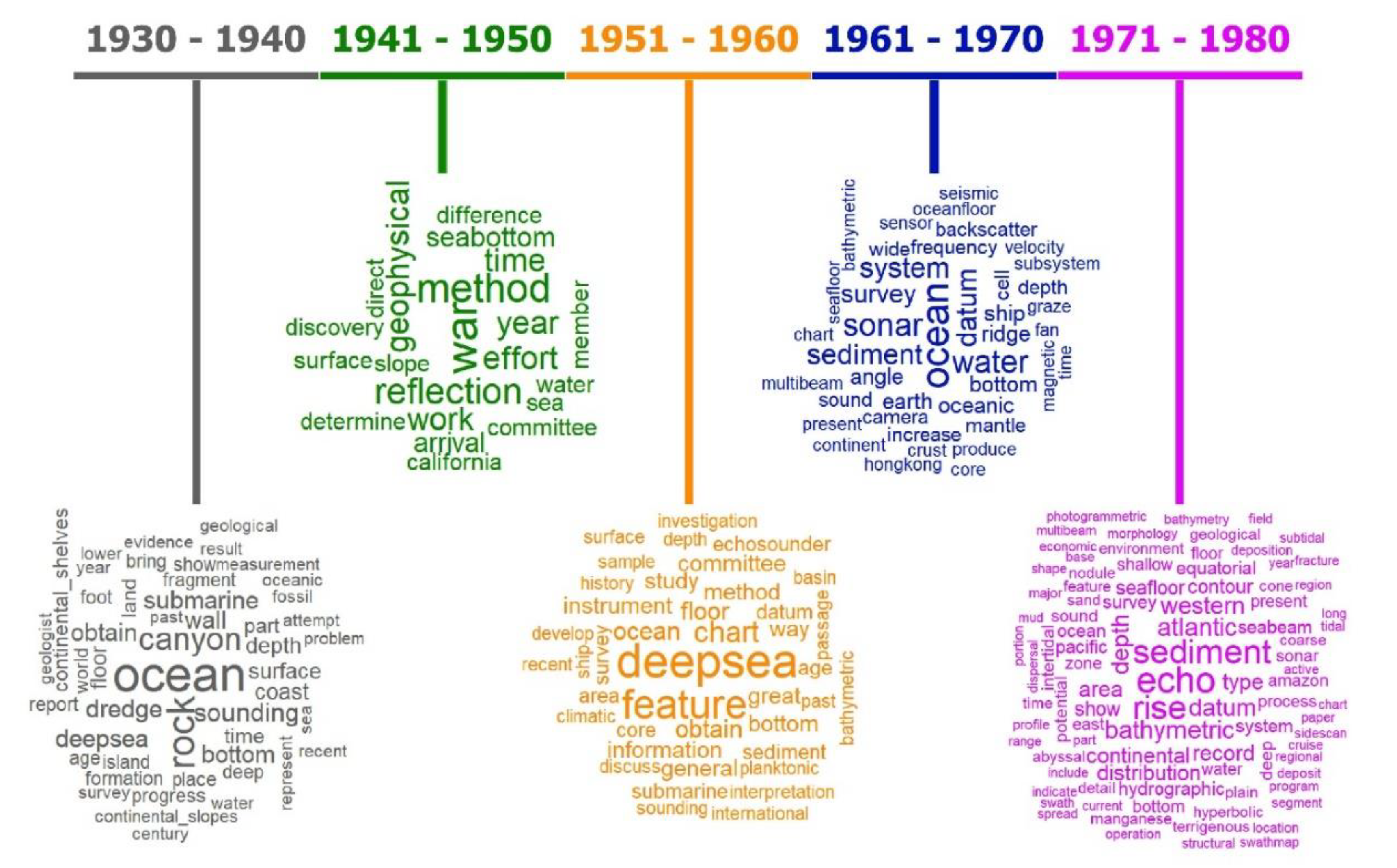
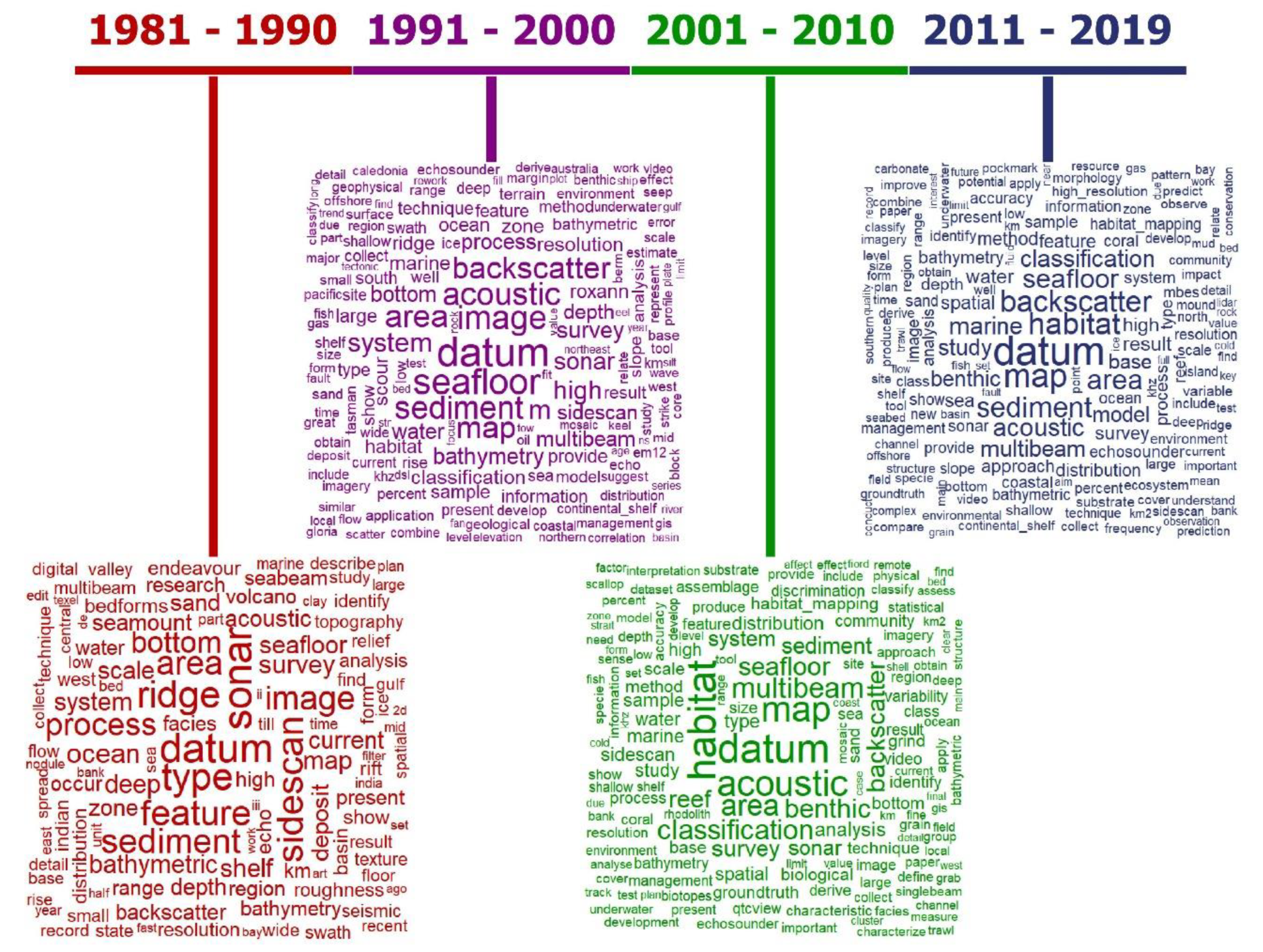
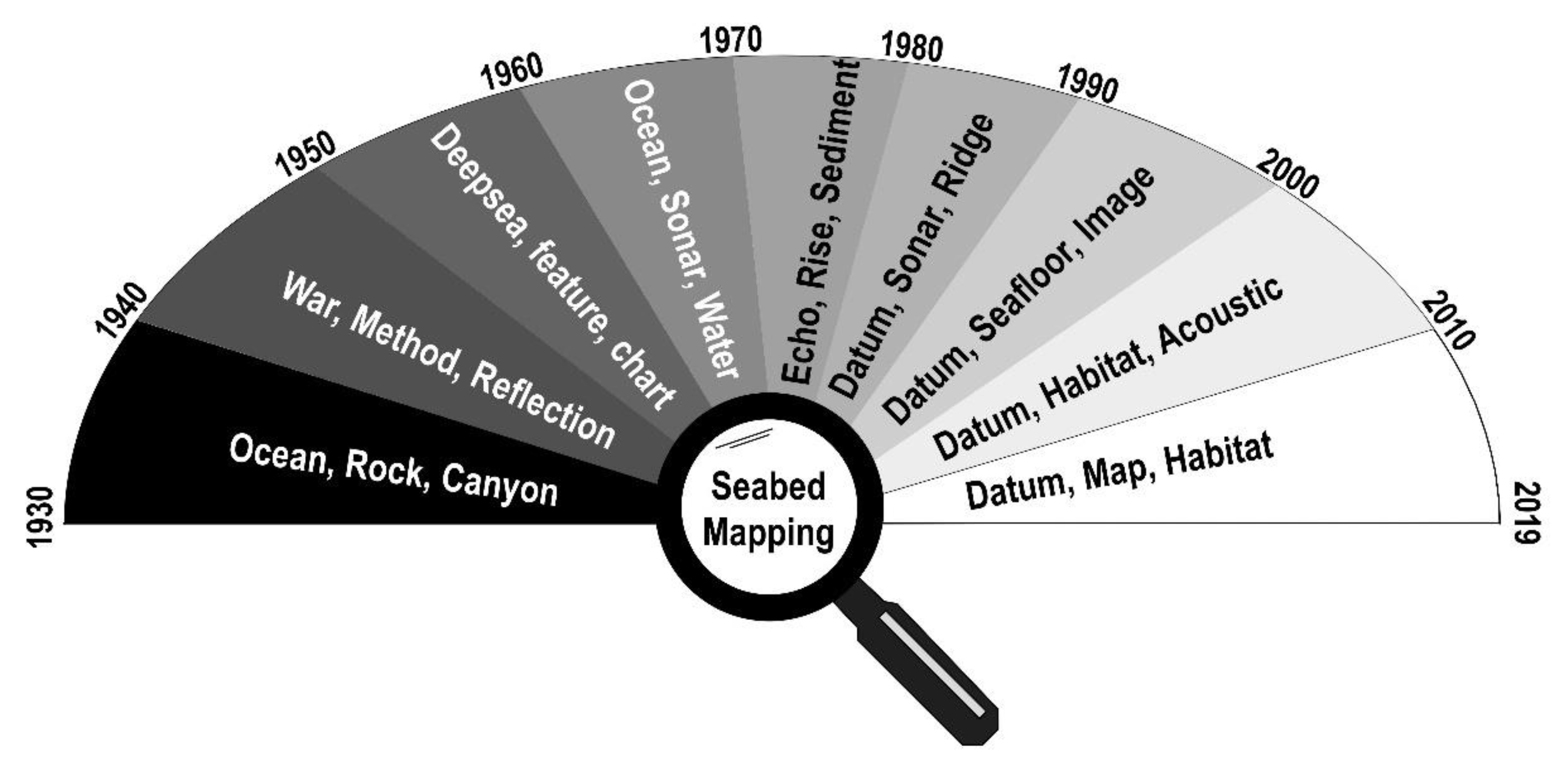

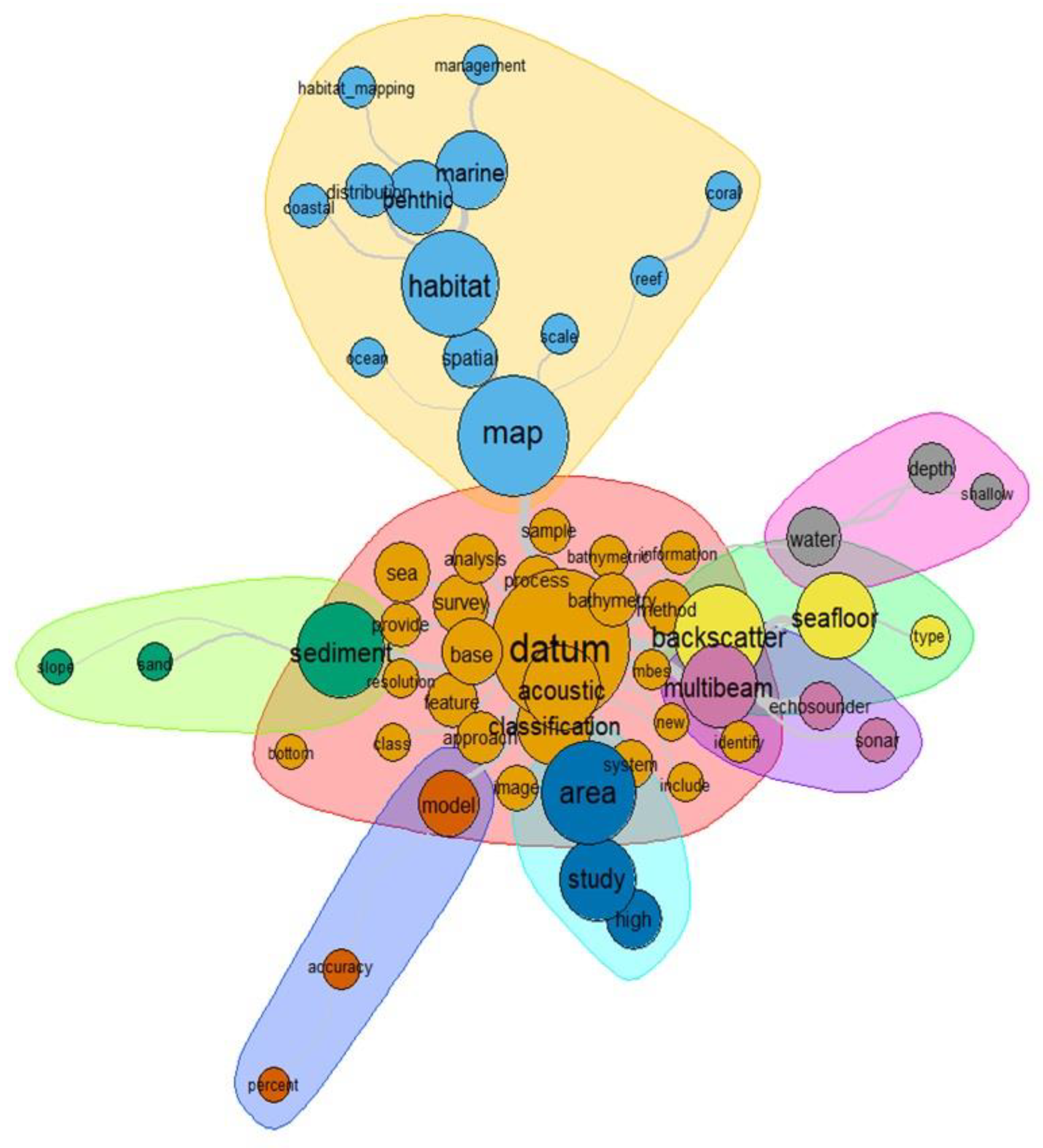
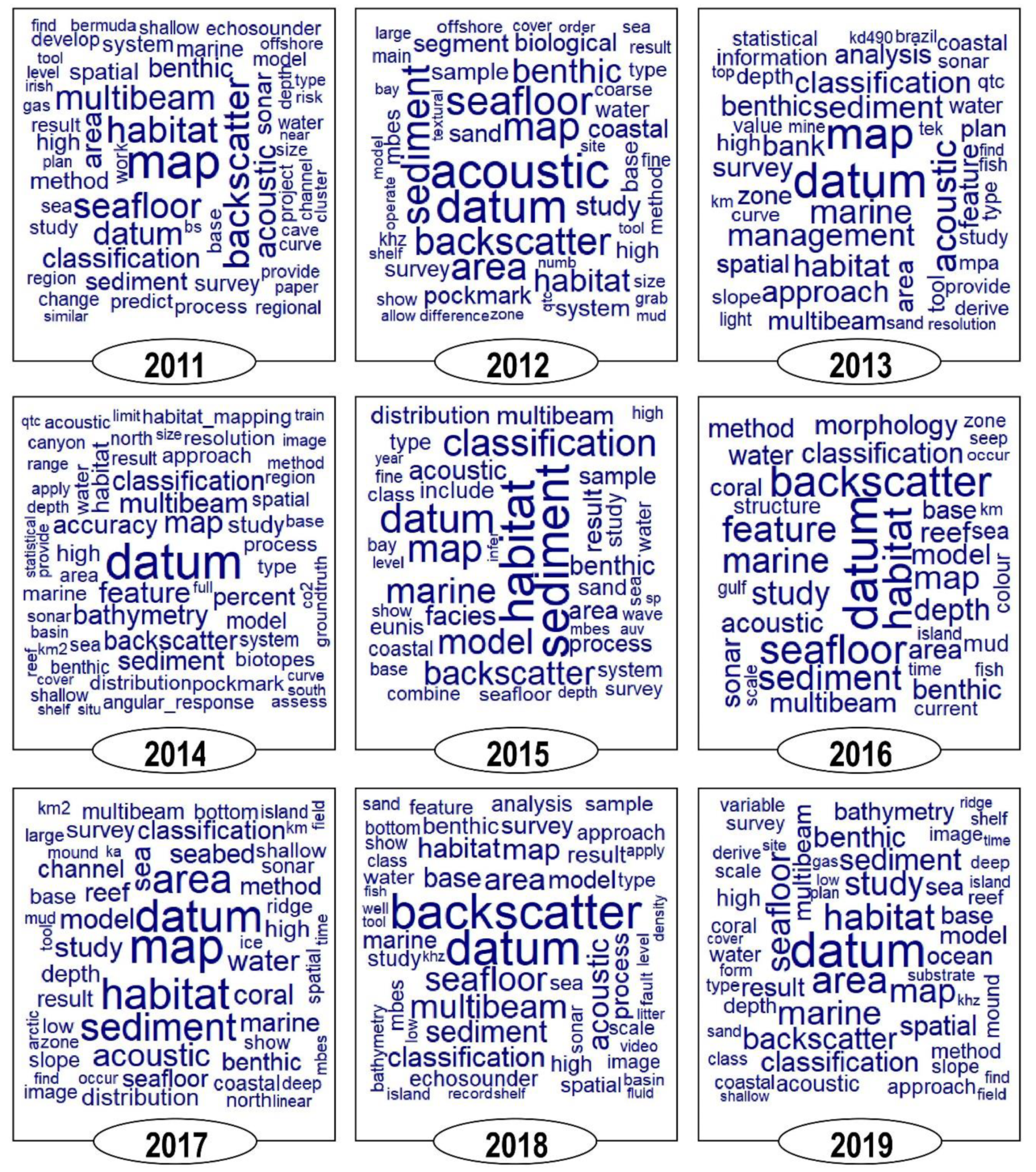
© 2020 by the authors. Licensee MDPI, Basel, Switzerland. This article is an open access article distributed under the terms and conditions of the Creative Commons Attribution (CC BY) license (http://creativecommons.org/licenses/by/4.0/).
Share and Cite
Smith Menandro, P.; Cardoso Bastos, A. Seabed Mapping: A Brief History from Meaningful Words. Geosciences 2020, 10, 273. https://doi.org/10.3390/geosciences10070273
Smith Menandro P, Cardoso Bastos A. Seabed Mapping: A Brief History from Meaningful Words. Geosciences. 2020; 10(7):273. https://doi.org/10.3390/geosciences10070273
Chicago/Turabian StyleSmith Menandro, Pedro, and Alex Cardoso Bastos. 2020. "Seabed Mapping: A Brief History from Meaningful Words" Geosciences 10, no. 7: 273. https://doi.org/10.3390/geosciences10070273
APA StyleSmith Menandro, P., & Cardoso Bastos, A. (2020). Seabed Mapping: A Brief History from Meaningful Words. Geosciences, 10(7), 273. https://doi.org/10.3390/geosciences10070273




